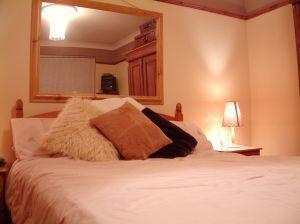As people age, or become disabled due to accident or injury, they need to safeguard themselves with simple at home injury prevention.
If you are having your parents come to visit, take a look around your home to make sure that is is safe to navigate for someone who doesn’t see well, or who has balance challenges.
As people age, their mobility decreases. Even if aging parents aren’t using a walker or wheelchair, they move more slowly, have less strength, reduced stamina, vision is weaker, sense of smell is reduced and hearing is not as sharp They may have trouble reaching up into cabinets to retrieve dishes. Take all these factors into consideration when rearranging a home to make it more safe for seniors.
There are many ways to make the home safer for seniors. In addition to the following suggestion, ask parents for their input. They likely have special needs that you can help them with.
The home can be made more safe with simple, easy to implement steps. Following are tips to make the home safe for seniors. Whether your concern is making their home safer, or making your home safer for a visit, these steps are fairly easy to implement.
1. Remove scatter rugs.Remove all rugs that are not attached. Loose rugs are easy to snag a toe in and are the cause of many falls.
2. Use non-skid wax and floor cleaners. Wax can make a floor slippery and can cause falls for people with poor balance.
3. Brighten lighting. Vision dims as we age. Good lighting is important so that parents can see their way around the home. Bright lighting in kitchen work areas reduces the risk of cuts and burns. Use at least 100 watt bulbs for readings. Use at least 60 watt bulbs in most other rooms. Place night lights in the pathways of the home, especially the route to the bathroom.
4. Stairs. Make sure the stairway is clutter free and brightly lit. If the stairs are difficult to see, the edge of each step can be marked with brightly lit electrical tape.
5. Electrical cords should be hidden. Move lamps and appliances close to walls so that electrical cords don’t’ lay in traffic areas where they can be tripped on. If you must extend an electrical across across a traffic area, secure the cord with tape. Brightly colored tape will draw attention to the cord. Don’t cover the cord with a rugs, as the bump will be disguised and becomes as tripping hazard.
6. Rearrange furniture. Move low furniture out of traffic areas. Move chairs closer together to make conversation easier for the hard of fearing. Low sitting decorative furniture can be a tripping hazard for people who don’t see well or are balance challenged.
7.. Lower water temperature. Most water heaters are set at an unnecessarily high heat which can cause scalding.
8. Bathmat. Wet floors, shower stalls and bath tubs can be slippery.. Use a textured bathmat to reduce the risk of falls.
9. Chair cushions to raise seats. The legs are not a strong and getting in and out of low cushioned chars and sofas can be difficult. The seating area can be temporarily raised be placing a pillow or folded blanket on the top of the seat.
10. Lamps and lights should be moved closer to the bed so that they can be easily reached while the parent is lying down.
11. Assistive devices. Consider raised toilet seats and grab bars to make the bathroom safer.
12. Reduce clutter. Clutter, such as clothes or socks left on the floor can be a tripping hazard.
13. Shelves. If they are going to be reaching for dishes or books kept on shelves, make sure that the items are placed on shelves low enough for them to reach easily.
14. Entrances. If there are any steps to get into the entrance to the house, a handrail to grip for balance can reduce risk of falling. Make sure the entrance is well lit so people can see clearly.
15. Steps and ramps. Steps can be difficult to navigate, even for seniors who are not in a walker or wheelchair. Consider building a ramp, or gradual slope. with a handrail for safety.
Information in this article is not intended a medical advice. Talk to your doctor about medical concerns.




